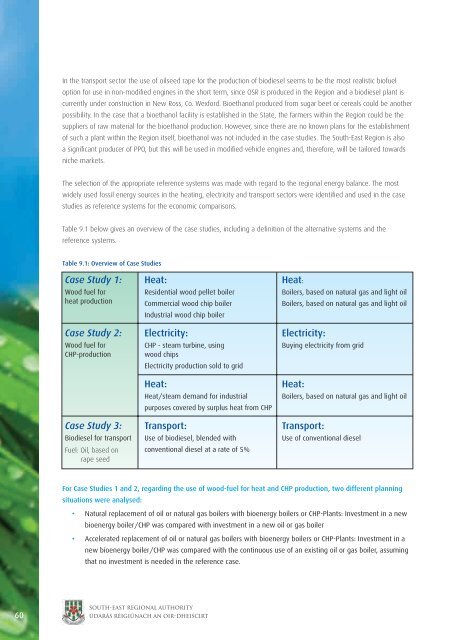Bioenergy Implementation Plan - South-East Regional Authority
Bioenergy Implementation Plan - South-East Regional Authority
Bioenergy Implementation Plan - South-East Regional Authority
You also want an ePaper? Increase the reach of your titles
YUMPU automatically turns print PDFs into web optimized ePapers that Google loves.
In the transport sector the use of oilseed rape for the production of biodiesel seems to be the most realistic biofuel<br />
option for use in non-modified engines in the short term, since OSR is produced in the Region and a biodiesel plant is<br />
currently under construction in New Ross, Co. Wexford. Bioethanol produced from sugar beet or cereals could be another<br />
possibility. In the case that a bioethanol facility is established in the State, the farmers within the Region could be the<br />
suppliers of raw material for the bioethanol production. However, since there are no known plans for the establishment<br />
of such a plant within the Region itself, bioethanol was not included in the case studies. The <strong>South</strong>-<strong>East</strong> Region is also<br />
a significant producer of PPO, but this will be used in modified vehicle engines and, therefore, will be tailored towards<br />
niche markets.<br />
The selection of the appropriate reference systems was made with regard to the regional energy balance. The most<br />
widely used fossil energy sources in the heating, electricity and transport sectors were identified and used in the case<br />
studies as reference systems for the economic comparisons.<br />
Table 9.1 below gives an overview of the case studies, including a definition of the alternative systems and the<br />
reference systems.<br />
Table 9.1: Overview of Case Studies<br />
Case Study 1:<br />
Wood fuel for<br />
heat production<br />
Case Study 2:<br />
Wood fuel for<br />
CHP-production<br />
Case Study 3:<br />
Biodiesel for transport<br />
Fuel: Oil, based on<br />
rape seed<br />
Heat:<br />
Residential wood pellet boiler<br />
Commercial wood chip boiler<br />
Industrial wood chip boiler<br />
Electricity:<br />
CHP - steam turbine, using<br />
wood chips<br />
Electricity production sold to grid<br />
Heat:<br />
Heat/steam demand for industrial<br />
purposes covered by surplus heat from CHP<br />
Transport:<br />
Use of biodiesel, blended with<br />
conventional diesel at a rate of 5%<br />
Heat:<br />
Boilers, based on natural gas and light oil<br />
Boilers, based on natural gas and light oil<br />
Electricity:<br />
Buying electricity from grid<br />
Heat:<br />
Boilers, based on natural gas and light oil<br />
Transport:<br />
Use of conventional diesel<br />
For Case Studies 1 and 2, regarding the use of wood-fuel for heat and CHP production, two different planning<br />
situations were analysed:<br />
• Natural replacement of oil or natural gas boilers with bioenergy boilers or CHP-<strong>Plan</strong>ts: Investment in a new<br />
bioenergy boiler/CHP was compared with investment in a new oil or gas boiler<br />
• Accelerated replacement of oil or natural gas boilers with bioenergy boilers or CHP-<strong>Plan</strong>ts: Investment in a<br />
new bioenergy boiler/CHP was compared with the continuous use of an existing oil or gas boiler, assuming<br />
that no investment is needed in the reference case.<br />
60<br />
south-east regional authority<br />
údarás réigiúnach an Oir-DheisCIrt





